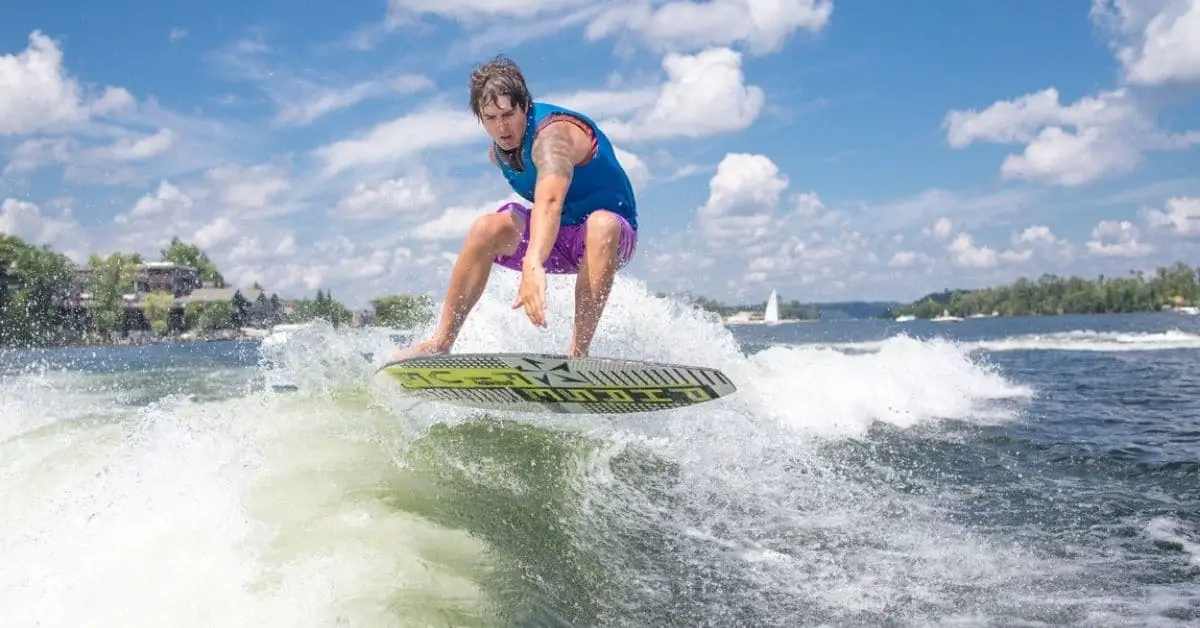Believe it or not, water depth actually has a large effect on how large your wake will be. Sometimes you can even tell when you ride over drop-offs or shallow spots because of how much the wake changes. Riding in water that’s too shallow also could cause some other problems such as vegetation de-rooting by all the sand that gets kicked up.
So how deep should the water be for wake surfing? Anything over 20 feet deep will be the best depth for wake surfing. At any depths below that, you will probably notice that the wake will get smaller. Although, wake surfing is still possible no matter the depth. I used to wake surf in 5-7 feet of water growing up and it worked just fine.
When wake surfing in shallow water, you might also not be able to fully fill your ballast because of how low the propeller will get in the water. Being so close to the ground could get your propeller tangled with weeds or hit by a rock/structure. If you do want to get a wake surfing boat for shallow water, I would recommend a jet-propelled one.
Many other factors contribute to the wake size besides the depth. The science of wake surfing is quite interesting, and many of these factors I share below could be used to help make your wake bigger.
Why is deeper water better for wake surfing?
In simple terms, the reason the wake is smaller in shallow water is that it gets cut off by the shallow water. When you make a large wake it is symmetrical just like any other wave. This means it is just as big underwater as it is above water. In shallow water, the wave gets cut off under the water by the ground which then creates a similar cut-off for the wave above ground, thus creating a smaller wake.
Should you change wake surfing speeds depending on lake depth?
Generally, the best speed for wake surfing is between 10 and 13 mph (source). You will most likely need to go slower in shallow water and use more weight in the back to create a large enough wake for wake surfing. Although, you need to be careful of hitting the bottom or kicking up too much sand.
Does the bottom of the lake have any effect on the size of the wake (rock, mud, sand)?
The bottom of the lake or river may also play a big role in the size and shape of your wake. Harder surfaces such as rocks or hard sand will cause the wake to be bigger while mushy surfaces such as muck and weeds will cause the wake to be smaller and poorly shaped.
Does the hull of your boat affect the size of the wake when wake surfing in different depths?
Another factor that contributes to wake size is the hull of your boat. There aren’t many studies on this topic, but after searching around on some forums someone actually found that hulls have a big effect on wake size in shallow water by comparing two different boats one a V-hull and the other a flat hull (source).
In shallow water, boats with flatter hulls will create a larger wake than those with V-shaped hulls. The difference isn’t extreme but it’s definitely noticeable.
How wake surfing in shallow lakes is causing harm to the vegetation
Having a lot of extra weight in the back of your boat will cause your propeller to go deeper into the water. This combined with the fact that the propeller is pointed more downward due to the tilt of the boat when wake surfing, causes a lot of sand to be kicked up in shallow lakes.
Sometimes when wake surfing in my old lake, we would turn a whole part of the lake brown due to all the sand kicked up. This can lead to vegetation being de-rooted and materials in the soil being released into the water which can cause polution.
Without vegetation, a lot of the aqua life will die out. Many lakes are banning ballasts or wake surfing in general because of this. So, just make sure you are wary of this when going wake surfing in shallow water.
- What Is The Cheapest Way To Store A Boat? - February 28, 2023
- Do Boats Need Bottom Paint? (Uncovering the Truth) - February 2, 2023
- How Much Is Bass Boat Insurance? (Real Quotes) - January 18, 2023

